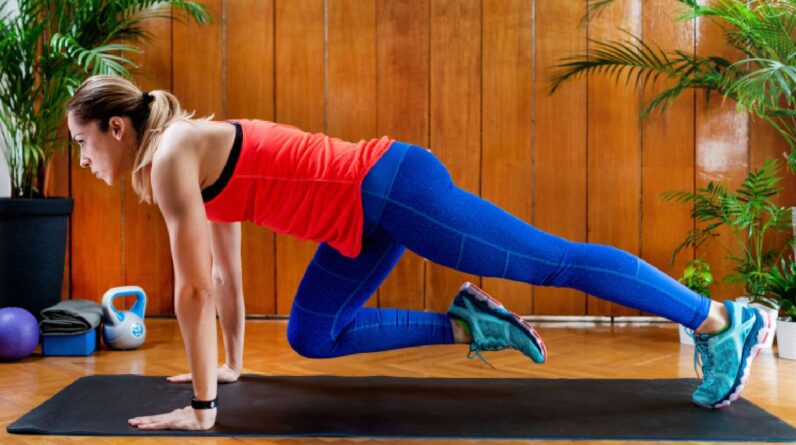
Isotonic exercise is a form of strength training that is beneficial for those looking to build muscle and lose weight. Exercises like lunges, and squats come under this type of training.
If you enjoy working out, your fitness routine probably includes exercises like squats, lunges, and push-ups. These are all examples of isotonic exercise, a form of strength training in which the muscles are required to resist weight over a range of motion. This type of training is not only good for improving physical strength, but also for flexibility, and balance. It is also an effective way to burn calories and get rid of extra body fat. As you explore the benefits of isotonic exercise, know which moves you can include in your fitness regime.
What is the isotonic exercise?
It is categorised as exercise which involves the contraction and shortening of muscles through a variety of movements, including those of the joint. “During this type of training, the body’s muscles change their length as per the movement to create and support joint movement with constant load or weight,” says fitness expert Aman Puri. This type of exercise overcomes resistance, where the body’s muscles keep a consistent level of tension or load during that movement.
It usually includes exercises like push-ups, and running or even everyday tasks like cleaning, or carrying groceries. Isotonic exercise can also be performed with equipment involving weightlifting machines, dumbbells and resistance bands.

What are the benefits of doing isotonic exercise?
1. Strengthens muscle and endurance
This type of exercise increases muscular strength and challenges muscles by focusing on repetitive movements that enhance endurance and improve overall strength. “In isotonic exercise, the muscles relax and contract through different range of motions, gaining more ability to handle repetitive and sustained movements,” says the expert. Isotonic exercise can improve muscle tone, increase physical power, and help build muscles, as per research published in Healthcare in 2022.
2. Improves flexibility and joint mobility
Isotonic exercise includes motions from a diverse range of movements, so it enhances flexibility and improves the mobility of joints. During a 2022 study, published in Applied Sciences, isotonic exercise was found to be effective in improving flexibility.
3. Promotes blood circulation
Isotonic exercise like running which involves dynamic and repetitive movements promotes cardiovascular health. “It enhances blood circulation and oxygenation, which can boost heart health. The pumping of the blood may also reduce the chances of stroke,” says Puri.
4. Enhances balance and coordination
In this type of exercise, muscles are worked upon in a controlled and repetitive manner, which improves neuromuscular control. “This controlled movement leads to balanced and better coordination by improving and stabilising muscles, flexing up the joints improving overall body movement,” says the expert
5. Helps manage weight
It helps improve metabolism and promote fat burning as they involve several muscle groups and require repetitive activity which helps burn more calories. Squat, a popular move, is an example of isotonic exercise. During a 2013 study, published in the Journal Of Sports Science And Medicine, researchers found that squat training significantly decreased body fat and increased the lean body mass in participants.
What is the difference between isometric and isotonic exercises?
- It may be beneficial for strengthening muscle mass and improving power and endurance. “On the other hand, isometric exercise may be beneficial for toning or for those recovering from injuries as it does not involve loading the muscles or increasing muscle tension,” says the expert.
- While performing isotonic exercise, the muscle length is shortened with constant tension or weight. On the other hand, while performing isometric exercise, the muscle length does not change as tension increases.
- Also, isotonic exercises involve joint movement whereas isometric exercises do not involve any joint movement.
What are the examples of isotonic exercise?
1. Lunges
- Take a step forward with one of your legs then gradually lower your hip with both your knees bent around 90 degree.
- Push your body through the front foot to go back to the starting position and do it again with your other leg.
2. Squats
- Stand up on your feet apart aligned with the shoulder-width.
- Bend your knee, lowering your hips and keeping your back in a straight position.
- Continue lowering your hips down till your thighs become parallel to the floor.
- Push up your body by returning back to a standing position while straightening your knees.
10 benefits of squats — and 7 squat variations to add variety to your fitness routine
3. Push-ups
- To perform push-ups, start with the position of the plank. Place your hands a little wider apart from shoulder width.
- Lower your body down by bending both your elbows reaching lower till your chest is near the ground level.
- Push up your body back keeping your back straight.
- Straighten your elbows as you push up your body and go back to the starting position.
4. Kettlebell swings
- In this isotonic exercise, first hold the kettlebell weight with both your hands and then stand by keeping your feet shoulder-width apart.
- Gradually bend your knees and swing back the kettlebell between both your legs, moving your hips forward trying to swing the kettlebell upto your chest level.
5. Leg press
- It is performed with the leg press machine. Sit by placing your feet shoulder-width apart on the machine’s platform.
- Extend your legs upwards, pushing the platform upwards.
- Gradually bend your legs back, lowering the weight down.

6. Jumping jacks
- Jumping jacks do not require any equipment. You just need to simply stand with arms straight.
- Start jumping while extending the feet apart and raising both your arms overhead in alternate movement.
- Jump back again to return back to the straight position.
7. Deadlift
- To carry out this exercise, stand with your feet and hips aligned to the same width.
- Grip the barbell with both hands in front of your thighs and start lifting the barbell while bending your knees, and lowering your hips.
- Lift the weight holding the barbell and then lower the barbell back to the ground keeping your back straight.
- After that return to the standing position, straightening the knees and hips.
8. Mountain climber exercise
- Start in a plank posture with your arms straight on the ground position and extending your legs backwards supported by your toes.
- Bring your knees in forward direction near the chest, and switch legs alternately.
Who should avoid doing isotonic exercise?
“Everyone can perform some form of isotonic exercise regularly,” says Puri.
- Since isotonic exercise also involves weights, those with sprains, muscle tears or bone injuries involving fractures and dislocation should avoid performing an intensive form as it may aggravate the risk of injuries.
- Those with cardiovascular issues like heart disease and high blood pressure should consult their doctor as performing isotonic exercise can raise blood pressure levels.
Isotonic exercise, a form of resistance training, is a great way to improve muscle strength and endurance. So, go for exercises like lunges, and deadlift to stay strong and fit.
You may also like


Related FAQs
Is yoga isotonic or isometric?
Yoga mainly involves isometric movements. Isometric muscle contractions can be seen in asanas like uttanasana (standing forward bend) and dandasana (staff pose), where moving from the plank position leads to the lengthening of muscles and joint movement while resisting gravity.
Is jumping isotonic?
Yes, jumping is an isotonic exercise as it involves altering the muscle length with muscle resistance in motion. Jumping is also known as a plyometric strengthening exercise and helps increase isotonic movement involving muscle contractions. It especially improves the vertical jumping ability.







